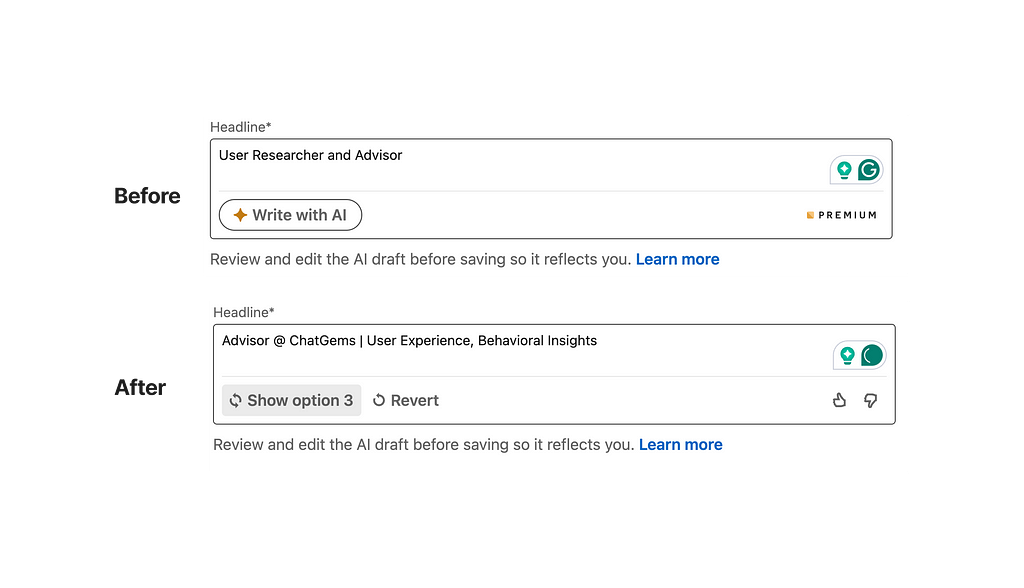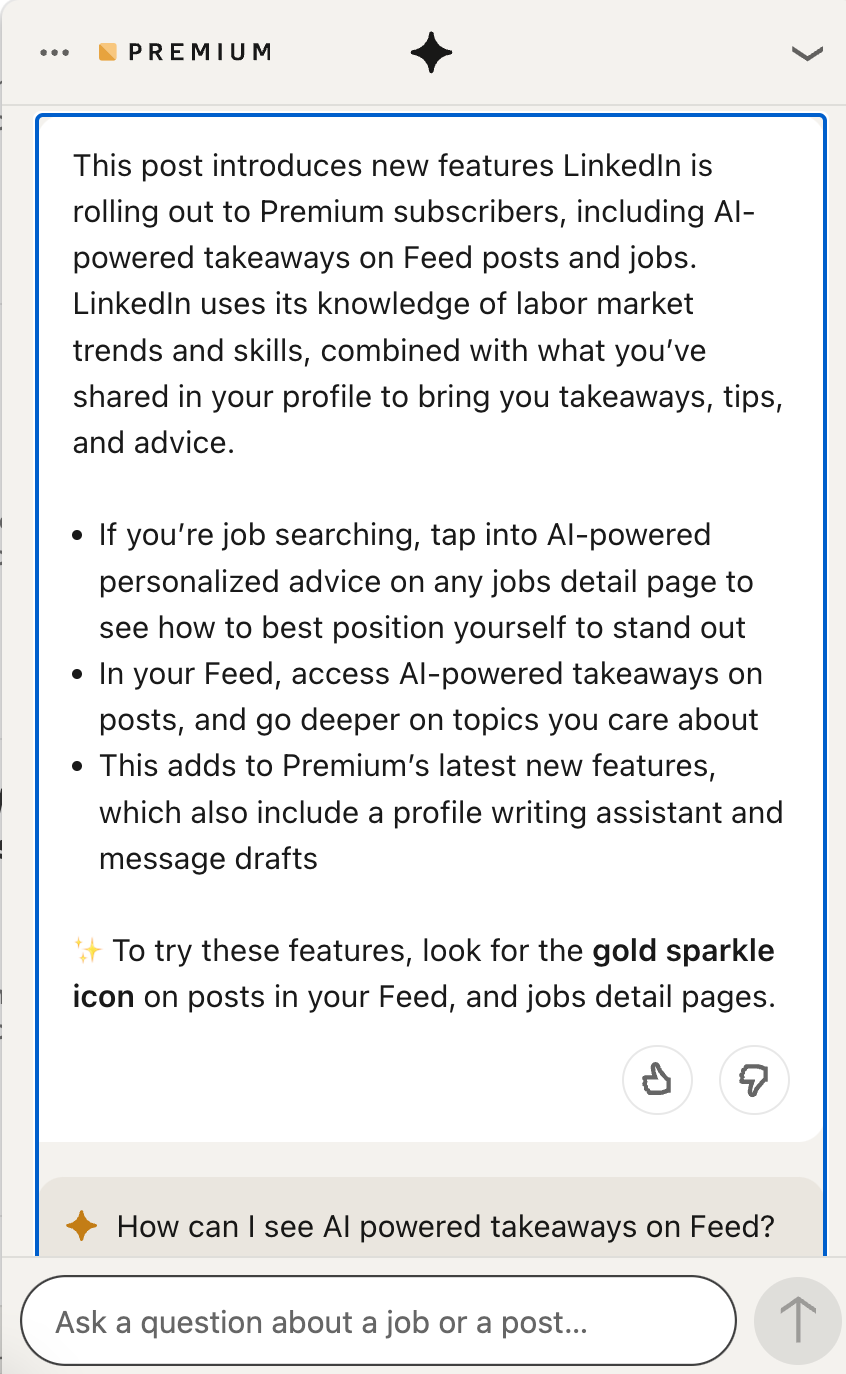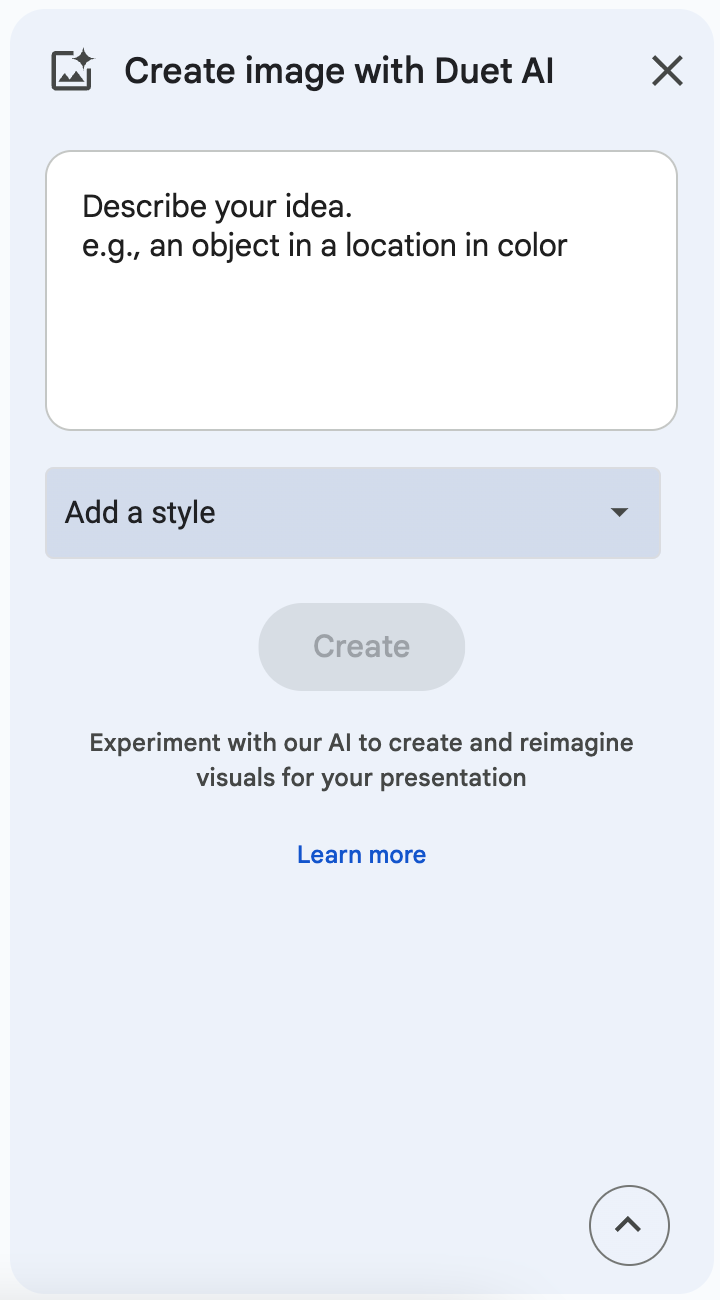Elevating user experience through intelligent content enhancement and personalization.

Chatbots serve as an accessible gateway to the realm of Generative AI features, a fact underscored by the success of ChatGPT. Their simplicity, requiring only basic instructions to engage in natural dialogues, allows them to integrate across various digital platforms seamlessly. Yet, the scope of these technologies extends well beyond mere conversational interfaces. The APIs from these advanced models can be woven into features to deliver substantial value enhancements, called “AI-enhanced features.” When devising features that involve either content generation or presentation, it’s crucial to consider the potential role of Generative AI.
The advent of models like GPT and Claude has dramatically reduced the cost of content creation, making sophisticated Large Language Models readily available. With appropriately crafted prompts, text can be effortlessly reshaped, expanded, or transformed, sparking a cascade of creative possibilities. These models excel at generating ideas, drafting project plans, uncovering themes in unstructured text, and much more. ChatGPT serves as a sandbox for exploring these capabilities and discovering myriad ways these tools can enhance professional tasks. However, this exploration shouldn’t end with individual use cases. The principle of leveraging these technologies to simplify processes can be extrapolated to enrich product features with AI.
Unlike chatbots, which facilitate direct interaction through conversational exchanges, AI-enhanced features leverage these technologies behind the scenes to refine and simplify the user experience. A prime example is Notion AI, which integrates LLM capabilities throughout its platform, allowing users to summarize meeting notes or clarify confusing points with a simple click. This implementation demonstrates the technology’s vast potential, even if it’s not always perfect.

The rationale behind Notion AI’s integration of Generative AI is clear, given its role as a repository for content. Yet, many products could benefit from similar innovations. Virtually every application involves some form of user input, whether during onboarding to gather insights or as part of core functionality in apps related to health tracking, productivity, or wellness, all relying on user-generated content.
Incorporating content from users presents two immediate opportunities for adding value through foundational LLM models like GPT. The first involves enhancing user input — what might be termed “upgrading” — and the second revolves around generating customized content for user consumption, a process we can call “personalization.” These approaches represent the beginning of integrating Generative AI into product design, hinting at the expansive potential for developing features with this transformative technology.
Upgrading Content
As illustrated by the Notion AI example, content upgrading transforms user-generated material into a format that better suits specific needs. This process might involve altering the format of user input — compressing, expanding, or entirely reshaping it. Additionally, it could enhance the style and tone, for instance, refining raw notes into a polished paragraph for a personal biography. There are numerous strategies for content upgrading, and here, we’ll explore four distinct methods through which this technology can be seamlessly integrated into a feature.
Punch ups
One of the most prevalent applications of Generative AI in enhancing features is the refinement of user-generated content, often referred to as “Punch Ups.” This process involves the AI taking initial input from the user and enhancing it by correcting grammar, simplifying readability, enriching with context, or implementing other quality improvements. Such enhancements present an opportunity to elevate the content’s utility for subsequent applications. A prime example of this is LinkedIn’s feature that reimagines a user’s headline based on their profile information. As illustrated below, a simple headline undergoes a transformation, offering the user multiple enhanced alternatives. This not only benefits the user by enriching their professional portrayal but also showcases the potential of “Punch Ups” to add significant value.

However, it’s crucial to navigate “Punch Ups” with caution. The reliance on Generative AI poses a risk of users placing too much trust in the system, which might sometimes generate inaccurate information or misconstrue facts. Therefore, it’s essential to ensure that users review the AI-enhanced content to verify its accuracy and remain rooted in reality. Moreover, maintaining the user’s ability to edit the AI’s output is critical, as it preserves their control and ability to refine the content further, safeguarding their autonomy.
While current implementations of “Punch Ups” like the LinkedIn example are relatively straightforward, the potential for this technology to revolutionize feature design is immense. Consider a goal-setting application prompting users to input personal objectives, such as “lose some weight.” The application could then apply a Generative AI prompt based on the SMART goal framework, transforming the vague goal into a more actionable and specific target, like “lose 5 pounds over the next month.” By enhancing the goal’s specificity and achievability, “Punch Ups” not only refine user input but also significantly improve the likelihood of goal attainment.
Starting Points
Embarking on a new project or task often presents the daunting challenge of facing a blank canvas, where limitless possibilities can paradoxically lead to stagnation. Generative AI offers a compelling solution by generating a range of initial options and drafts, challenging human biases and enabling users to start with a foundational piece they can tailor to their needs. This technology becomes particularly valuable when users confront an empty screen demanding content creation.
Grammarly exemplifies this application within its platform, offering users an AI assistant upon initiating a new document. This assistant provides various starting points, such as frameworks for a project progress report or blog post ideas, requiring only minimal input to guide the AI toward a relevant context. Following this, Grammarly’s system generates initial content, which users can refine using preset options or additional instructions. Ultimately, this content can be seamlessly transferred into a document for final adjustments.

The Grammarly case underscores Generative AI’s capacity to transition users from a standstill to a productive starting point. However, it also highlights the importance of incorporating design elements that encourage users to evaluate the AI-generated content for accuracy critically. Despite the efficiency of these systems, they lack the nuanced context a human brings to content creation, necessitating user input to ensure the final content’s relevance and utility. Additionally, there’s a risk that reliance on Generative AI for brainstorming may overlook more suitable options, underscoring the need for critical engagement from the user.
Generative AI’s potential in crafting initial drafts is immense, as I’ve personally experienced using ChatGPT to refine and expand my ideas for new projects. Looking ahead, I envision To-Do applications generating comprehensive action lists from brief user inputs and social media platforms suggesting content topics based on users’ past contributions. This evolution in Generative AI’s application promises not only to facilitate the creative process but also to inspire innovation by challenging our initial concepts and expanding our idea horizons.
Summarization
In scenarios where content abounds, distilling it into a more concise form becomes essential. Summarization for rapid consumption is a trend gaining momentum, as evidenced by platforms like Blinkist, which distill key insights from popular non-fiction books. Generative AI promises to apply similar conciseness across various content forms, paving the way for services that could summarize podcasts, newsletters, and more. Within products, this capability presents vast opportunities.
LinkedIn is at the forefront, tackling the straightforward task of summarizing lengthy posts and articles. As demonstrated, I generated a succinct summary of a post detailing the AI’s summarization prowess. Intriguingly, LinkedIn opts to present this summarized content within a chat interface, facilitating a dialogue where questions about the post could be raised. This approach represents a significant stride towards making the web’s vast content more navigable.

Yet, summarization must navigate the usual pitfalls of accuracy and context. Moreover, condensing content necessitates editorial choices regarding what to include and exclude. While simplifying a factual LinkedIn post, as in the example, seems straightforward, condensing news articles into a few sentences could pose challenges. Additionally, these systems sometimes overlook subtle details or thematic nuances, a limitation that could extend to summaries, potentially omitting critical themes or insights.
Looking ahead, the potential applications for summarization extend far beyond. For platforms that accumulate user data over time, Generative AI could offer “summaries” that reveal patterns in a user’s behavior. Consider a digital journal tracking daily thoughts and feelings; currently, identifying patterns requires quantifying emotions or conducting laborious thematic analysis. As Generative AI technologies evolve, they promise to unlock profound longitudinal insights. Similarly, these tools could craft narratives around assessment outputs, like a mental health platform offering personalized insights based on psychological assessments. The horizon for Generative AI in summarization is vast, heralding a future where content is not only more accessible but also more insightful.
Visualization Creation
Venturing beyond the realm of textual content, the final component we explore is the application of Generative AI in crafting visual content. This leap into the visual domain introduces the possibility for users to have images generated on their behalf rather than solely relying on existing photographs. A prime example of this innovative use is in Google Slides, where the Duet AI feature allows users to create an image for their title slide. This initial step effectively transitions users from confronting a blank canvas to possessing a source of inspiration that can guide the creation of their entire presentation.

While the example from Google Slides illustrates a nascent foray into this territory, the potential applications for image generation via Generative AI are vast and varied. Images possess the unique ability to convey complex messages instantly, suggesting a future where communication might increasingly leverage AI-generated visuals. For instance, a mental health platform could enable users to articulate their feelings through images rather than text, offering a more intuitive expression of emotion. Similarly, fashion retailers could harness this technology to generate diverse clothing style images, sparking creativity and helping users visualize potential wardrobe additions.
However, as with any emerging technology, image generation through Generative AI faces its own set of challenges. Despite efforts to train these systems to avoid producing inappropriate or copyrighted content, safeguards are not infallible. Additionally, the potential for perpetuating biases through generated images remains a significant concern, highlighting the need for ongoing refinement and ethical considerations in the technology’s development.
The excitement for their potential is palpable as we stand on the cusp of integrating these visual generation technologies into products. The journey ahead promises innovative applications that will enrich user experiences, offering new ways to inspire, communicate, and engage through the power of visual creation.
Content Personalization
Every component discussed thus far hinges on user-provided content, ripe for the transformative touch of AI-enhanced features. The flip side of this equation involves generating entirely new content from the ground up, informed by user descriptors supplied by the company. The dramatic decrease in content creation costs now enables the production of customized content variations targeting specific groups or even individual users, responding to the desire of consumers for personalization.
At its core, this process begins with crafting personalized communications, such as notifications or emails tailored to resonate with distinct audiences. An illustrative example of the power of personalization is Duolingo, which has observed significant upticks in usage and retention through targeted push notifications. This approach is underpinned by behavioral science, which acknowledges diverse strategies to nudge user behavior; no singular message will captivate every user universally. Instead, a nuanced understanding of each user’s objectives, progress, and motivations becomes crucial. With this insight, it’s possible to devise customized messages employing various behavioral techniques to encourage desired actions.
Historically, generating a multitude of tailored content versions was a daunting, time-intensive endeavor. Generative AI revolutionizes this process, swiftly creating multiple content iterations based on specified parameters. Consider a notification prompt like “Check this app for your latest offer.” With tools like ChatGPT, one can quickly generate variations of this message, tailored for an iOS notification format and incorporating behavioral principles like Loss Aversion, Choice Overload, and Social Norms, producing several new versions ready for user testing. The possibilities expand with more detailed user context.
This personalized approach to notifications and emails is merely the starting point. Many organizations maintain a repertoire of articles, blog posts, and similar content to highlight their domain expertise, aiming to engage as broad an audience as possible. With Generative AI, creating customized versions of these materials for specific subgroups becomes a straightforward task. For instance, a weight loss app could adapt an article on establishing new workout routines for various demographic segments, followed by targeted notifications to those groups. Looking ahead, I anticipate applications will extend to customizing content based on user data generated through interaction with the company’s services.
Expanding on customization for subgroups, conversations with startups venturing into this domain suggest that dynamically personalized webpages, tailored in real-time to the visitor, are on the horizon. For instance, SaaS websites currently employ tools like Mutiny to tailor experiences based on the visitor’s profile, offering distinct content to founders versus HR leads. While this still demands human input for content creation, the landscape is poised for rapid evolution, minimizing the need for manual intervention.
Just the beginning
Generative AI is just scratching the surface regarding its potential to craft AI-enhanced features, signaling an exciting frontier of innovation still to be fully explored. Viewing Generative AI merely as a tool for creating chatbots significantly underestimates its capacity to revolutionize product features across various domains. This article has spotlighted two particularly accessible applications: refining user-generated content and customizing content for enhanced personalization. Yet, these are merely the tip of the iceberg, with countless other applications poised to unfold as the technology matures.
From this moment forward, scrutinize every facet of your product involving user interaction, whether inputting data or consuming content. Consider how you can apply the fundamental components we’ve discussed to enrich the content, facilitating users to meet their needs more effectively. When it comes to presenting content to your audience, why not try out a variety of options? Test, refine, and expand your approach. The realm of possibilities is boundless; it all boils down to embracing experimentation.
Generative AI’s journey in enhancing product features is just beginning, and a vast landscape of untapped potential marks its trajectory. As we venture further into this domain, the anticipation of discovering new and innovative applications of this technology grows. The key is to remain open to experimentation, constantly seeking ways to leverage Generative AI to deliver more value to users and elevate their experience with your product.
Designing genAI-enhanced features was originally published in UX Collective on Medium, where people are continuing the conversation by highlighting and responding to this story.